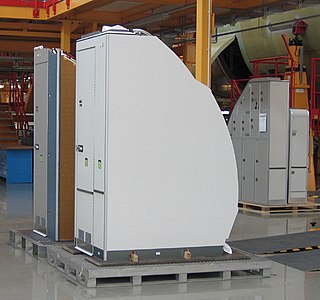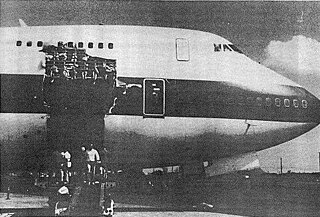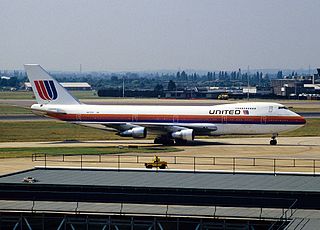United Airlines, Inc. is a major airline in the United States headquartered at the Willis Tower in Chicago, Illinois. United operates an extensive domestic and international route network across the United States and all six inhabited continents primarily out of its seven hubs, with Chicago–O'Hare having the largest number of daily flights and Denver carrying the most passengers in 2023. Regional service is operated by independent carriers under the brand name United Express.

A flight attendant, also known as a steward or stewardess, or air host or hostess, is a member of the aircrew aboard commercial flights, many business jets and some government aircraft. Collectively called cabin crew, flight attendants are primarily responsible for passenger safety and comfort.

Air France Flight 8969 was an Air France flight that was hijacked on 24 December 1994 by the Armed Islamic Group of Algeria (GIA) at Houari Boumediene Airport, Algiers. The terrorists murdered three passengers and their intention was either to detonate the aircraft over the Eiffel Tower or the Tour Montparnasse in Paris. When the aircraft reached Marseille, the National Gendarmerie Intervention Group (GIGN), a tier one counterterrorism and hostage rescue unit of the French National Gendarmerie, stormed the plane and killed all four hijackers.

On December 22, 2001, a failed shoe bombing attempt occurred aboard American Airlines Flight 63. The aircraft, a Boeing 767-300ER with 197 passengers and crew aboard, was flying from Charles de Gaulle Airport in Paris, France, to Miami International Airport in the U.S. state of Florida.

Philippine Airlines Flight 434, sometimes referred to as PAL434 or PR434, was a scheduled flight on December 11, 1994, from Manila to Tokyo with a quick stopover in Cebu on a Boeing 747-283B that was seriously damaged by a bomb, killing one passenger and damaging vital control systems, although the plane was in a repairable state. The bombing was a test run of the unsuccessful Bojinka terrorist attacks. The Boeing 747 was flying the second leg of a route from Mactan–Cebu International Airport in Cebu, Philippines to Narita International Airport, in Tokyo, Japan. After the bomb detonated, 58-year-old veteran pilot Captain Eduardo "Ed" Reyes was able to land the aircraft, saving it and the remaining passengers and crew.

The mile high club is slang for people who have had sexual intercourse on board an aircraft during flight. While this usually refers to sexual acts in an airliner lavatory, a sexual act anywhere on a plane in flight would fit the term. The actual height of the aircraft at the time the act takes place is not relevant; sexual activity in a plane flying 10 feet off the ground would still qualify.
Air rage is aggressive or violent behavior on the part of passengers and crew of aircraft, especially during flight. Air rage generally covers both behavior of a passenger or crew member that is likely caused by physiological or psychological stresses associated with air travel, and when a passenger or crew member becomes unruly, angry, or violent on an aircraft during a flight. Excessive consumption of alcohol is often a cause.

United Airlines Flight 811 was a regularly scheduled international flight from Los Angeles to Sydney, with intermediate stops at Honolulu and Auckland. On February 24, 1989, the Boeing 747-122 serving the flight experienced a cargo-door failure in flight shortly after leaving Honolulu. The resulting explosive decompression blew out several rows of seats, killing nine passengers. The aircraft returned to Honolulu and landed without further incident.

Singapore Airlines Flight 006 was an international scheduled passenger flight from Singapore Changi Airport to Los Angeles International Airport via Chiang Kai-shek International Airport near Taipei, Taiwan. On 31 October 2000, at 11:18pm Taipei local time, the Boeing 747-412 operating the flight attempted to take off from the wrong runway at Chiang Kai-shek International Airport during a typhoon. The aircraft crashed into construction equipment on the runway, killing 83 of the 179 people aboard. Ninety-eight occupants initially survived the accident, but two passengers died later from injuries in hospital. It was the first fatal accident involving a Boeing 747-400.

On December 28, 1997, United Airlines Flight 826 was operated by a Boeing 747-100 flying from New Tokyo International Airport (Narita), Japan to Honolulu International Airport, Hawaii. Two hours into the flight, at an altitude of 31,000 feet (9,400 m), the plane received reports of severe clear-air turbulence in the area and the seat belt sign was turned on. Moments later, the aircraft suddenly dropped around 100 feet (30 m), seriously injuring 15 passengers and 3 crew members. The plane turned around and landed safely back in Tokyo, but one passenger, a 32-year-old Japanese woman, died.

British Airways Flight 149 was a flight from London Heathrow Airport to Subang International Airport, then the international airport for Kuala Lumpur, Malaysia, via Kuwait and Madras International Airports, operated by British Airways using a Boeing 747-136, with registration G-AWND, on 2 August 1990.

QantasLink Flight 1737 was an afternoon Australian domestic flight from Melbourne Airport to Launceston Airport, which was subject to an attempted hijacking on 29 May 2003.

An aircraft lavatory or plane toilet is a small unisex room on an aircraft with a toilet and sink. They are commonplace on passenger flights except some short-haul flights. Aircraft toilets were historically chemical toilets, but many now use a vacuum flush system instead.

The Korean Air Lines YS-11 hijacking occurred on 11 December 1969. The aircraft, a Korean Air Lines NAMC YS-11 flying a domestic route from Gangneung Airbase in Gangneung, Gangwon, South Korea to Gimpo International Airport in Seoul, was hijacked at 12:25 PM by North Korean agent Cho Ch'ang-hŭi (조창희). It was carrying four crewmembers and 46 passengers ; 39 of the passengers were returned two months later, but the crew and seven passengers remained in North Korea. The incident is seen in the South as an example of the North Korean abductions of South Koreans.

The JetBlue flight attendant incident occurred after JetBlue Airways Flight 1052, from Pittsburgh to New York City on August 9, 2010, had landed at John F. Kennedy International Airport. Steven Slater, a veteran flight attendant announced over the plane's public address system that he had been abused by a passenger and was quitting his job. He then grabbed and drank two beers and exited the plane by deploying the evacuation slide and sliding down it. Slater claimed to have been injured by a passenger when he instructed her to sit down. His account of the event was not corroborated by others who claimed he hip-checked the woman.

Scandinavian Airlines System Flight 347 was a scheduled domestic flight which, on 3 November 1994, was hijacked shortly after take-off. The flight, from Bardufoss Airport via Bodø Airport to Oslo Airport, Fornebu in Norway, was operated by a McDonnell Douglas MD-82 belonging to Scandinavian Airlines System (SAS). The hijacker was Haris Keč, a Bosnian living in Norway, who made demands that Norwegian authorities help to stop the humanitarian suffering in his home country caused by the Bosnian War. No one was injured in the incident.

Tianjin Airlines Flight 7554 was a scheduled domestic passenger flight between Hotan and Ürümqi in China's Xinjiang Autonomous Region. On 29 June 2012, an Embraer E190 operating the flight, took off from Hotan at 12:25 pm; within ten minutes, six ethnic Uyghur men, one of whom allegedly professed his motivation as jihad, announced their intent to hijack the aircraft, according to multiple witnesses. In response, passengers and crew resisted and successfully restrained the hijackers, who were armed with aluminium crutches and explosives.

The nut rage incident, colloquially referred to as "nutgate", was an air rage incident that occurred on December 5, 2014, at John F. Kennedy International Airport in New York City onboard Korean Air Flight 086. Korean Air vice president Heather Cho, dissatisfied with the way a flight attendant served nuts on the plane, ordered the aircraft to return to the gate before takeoff.

On 3 February 1975, 197 people fell ill aboard a Japan Air Lines Boeing 747 en route from Anchorage, Alaska, to Copenhagen, Denmark, after consuming an in-flight meal contaminated with Staphylococci. One hundred and forty-four people needed hospitalization, making it the largest food poisoning incident aboard a commercial airliner.

















